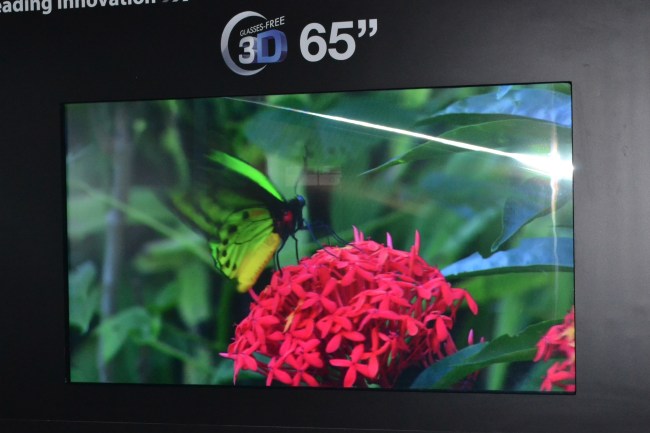
Ever since man donned bulky 3D glasses to experience true 3D from a television screen, he has dreamed of shedding them, stepping on them, and quite possibly, burning the remains. This year, that will become a reality for the well-heeled and patient consumer. While many manufacturers rolled into CES 2011 with TVs that use lighter, less expensive passive glasses, Toshiba went a step further and eliminated them entirely. The company will be one of the first on the consumer market to offer true, big-screen glasses-free 3D televisions, not prototypes but real consumer models that will hit the market in the second half of 2011. We got a chance to check out both in person at Toshiba’s CES 2011 exhibit.
Both televisions use parallax barriers to generate the 3D effect, which are basically tiny slits within the TV send different images to each eye – depending on where you stand. Toshiba’s sets have nine parallax zones, meaning there are 9 different areas around the TV you can stand to experience true 3D as it was intended. In between, the left- and right-eye images become disjointed.
In person, this basically means you need to watch the TV and keep moving until the 3D image catches – and stay in the sweet spot. A little head movement from side to side won’t hurt, but even a tiny step from side to side at 10 feet away can make or break image quality. Besides the dead spots this will leave on your couch where no one can experience 3D, it also restricts movement, which might be tolerable for a TV show but would probably feel like a prison sentence over the course of a two-hour movie.

When it works, it works well, but not perfectly. Toshiba claims all nine zones off the same experience, but we found the dead center spot offered tremendously improved picture quality that’s deeper, clearer, and a more solid-looking. Off to the side, the 3D effect seemed to lose most of its fizz, flattening to a level that almost requires you to focus to even notice the 3D.
Even under ideal conditions, the image doesn’t have the same in-your-face effect as our favorite 3D TVs from Panasonic, but it does have one leg up on any glasses solution besides convenience: It’s brighter. Because any form of glasses block the light to one eye half the time, they often result in a dim image that Toshiba’s glasses-free 3D TVs don’t exhibit.
Since the parallax barrier technique effectively halves the resolution of the TV by sending half the pixels to one eye and half to another, Toshiba had to step resolution on the screens up from the usual 1080p to 4K. It did seem to preserve the fidelity of source material in 3D, and it will also offer true 4K resolution when it operates in 2D mode. Both TVs will also offer CEVO, Toshiba’s suite of tools derived from Cell TV, including Resolution+ for enhancing source content and 2D to 3D conversion.
Toshiba promises that its glasses-free displays will go on sale to consumers in the second-half of this year, but prices remain a distant talking point that likely won’t be on the table for months. After our hands-on time with the prototypes, we aren’t convinced the first generation of this technology will be a hit with mainstream consumers, but Toshiba’s progress in 3D from last year and the fact that it plans to offer the displays commercially this year, both seem like solid indications that mankind won’t be bound by the weight of 3D glasses forever.
Editors' Recommendations
- You Asked: 3D VR, QDEL technology, and TV size vs. quality
- Samsung, Google are attacking Dolby Atmos’ monopoly on 3D sound, and it’s going to get ugly
- What is MPEG-H? The burgeoning 3D audio standard explained
- Look out! 3D TVs could be poised to make a surprising comeback


